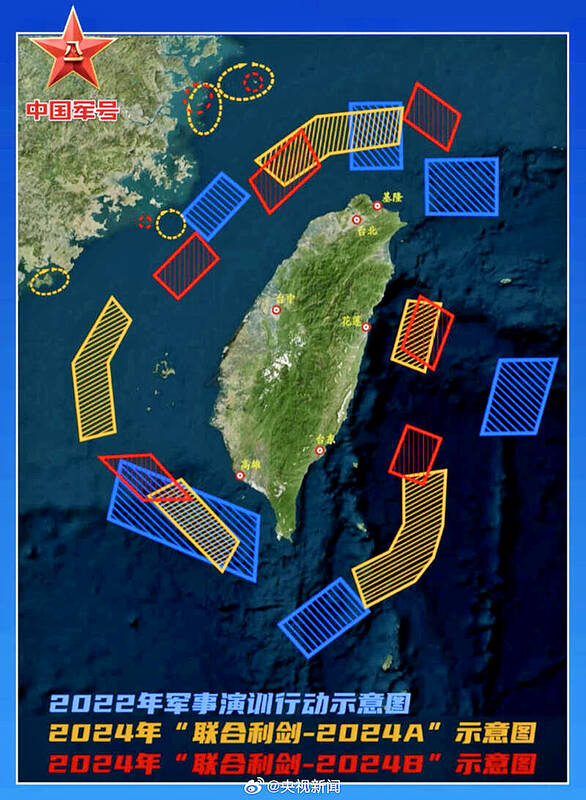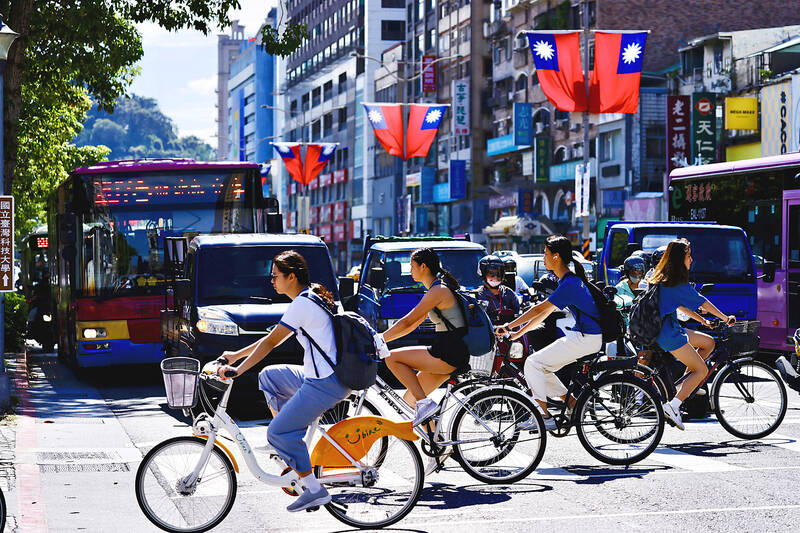Although China’s “Joint Sword-2024B” military exercises around Taiwan on Monday were apparently shorter than the previous “Joint Sword-2024A” drills, they were intense in terms of swift simulated attacks and deployment of ships and aircraft.
The previous large-scale military drills encircled Taiwan on May 23 and 24, the purpose of which was to respond to President William Lai’s (賴清德) May 20 inaugural address.
Lasting only 13 hours, Monday’s exercises came four days after Lai delivered his first Double Ten National Day address, in which he said the People’s Republic of China has “no right to represent Taiwan” and reiterated that the two sides of the Taiwan Strait were “not subordinate” to each other.

Photo: Screen grab from the Chinese People’s Liberation Army Eastern Theater Command’s Sina Weibo account
The Chinese People’s Liberation Army (PLA) said that part of the drills practiced what it called a “key port blockade”, severing Taiwan’s maritime lifeline for imports of trade, food and energy.
It aimed to show China’s ability to stop energy imports, especially at ports offloading liquefied natural gas (LNG), PLA National Defense University professor Zhang Chi (張弛) told China’s Global Times.
“The People’s Liberation Army wants to prove that we have the ability to block the import of energy resources for Taiwan, thereby having an important impact on the economy and society,” the newspaper quoted Zhang as saying.

Photo: Ritchie B. Tongo, EPA-EFE
Foreign military attaches and analysts said this element of the drills is being closely scrutinized, as such a tactic could pressure and isolate Taiwan ahead of any full-blown invasion.
State-run energy company CPC Corp, Taiwan said LNG imports had been unaffected by the drills, decrying as false news online suggestions to the contrary.
“This time there was a rather special component, the so-called quarantine or blockade, during which they practiced their blockading abilities,” said Su Tzu-yun (蘇紫雲), director of defense strategy and resources at the government-funded Institute for National Defense and Security Research.
The drill zones portrayed in a map issued by the PLA were closer to Taiwan than in previous exercises, with all, for the first time, including areas within Taiwan’s 24 nautical mile (44.4km) contiguous zone.
“All the drill zones they announced are more closely approaching Taiwan proper, and all include the 24 nautical mile zone,” said Ma Chen-kun (馬振坤), director of the Graduate Institute of China Military Affairs Studies at National Defense University.
The China Coast Guard, now the world’s largest by far, was more heavily involved in the drills than earlier, encircling the Taiwan-controlled Matsu islands near the Chinese coast and operating on both sides of Taiwan proper.
Taiwan is particularly wary of China Coast Guard efforts to board civilian ships on law enforcement grounds.
Such instances could be a serious provocation that the Coast Guard Administration (CGA) would do everything to prevent, CGA Deputy Director-General Hsieh Ching-Chin (謝慶欽) said on Monday.
Previous Chinese war games have been accompanied by the release of military videos of animations of missile attacks on Taiwan.
This time, one caricatured Lai with devil-like pointed ears, in what one security source in Taiwan called an unusually personal attack on a man Beijing already detests as a “separatist.”
China also released two less slickly made videos of navy sailors commenting on weather conditions and their locations, close to the ports of Keelung and Kaohsiung.
In Taiwan, television stations show such videos as part of regular drill coverage. The government calls them part of “cognitive warfare” waged to sap confidence in its military.
Shortly after Monday’s drills began, the CGA said it detained a Chinese citizen using a rubber boat to approach Menghu Islet (猛虎嶼) near Kinmen County and opposite Xiamen, China.
The CGA said it could not rule out the incident as one of China’s “gray zone” activities threatening outlying islands during the drills.
Additional reporting by staff writer

The disruption of 941 flights in and out of Taiwan due to China’s large-scale military exercises was no accident, but rather the result of a “quasi-blockade” used to simulate creating the air and sea routes needed for an amphibious landing, a military expert said. The disruptions occurred on Tuesday and lasted about 10 hours as China conducted live-fire drills in the Taiwan Strait. The Civil Aviation Administration (CAA) said the exercises affected 857 international flights and 84 domestic flights, affecting more than 100,000 travelers. Su Tzu-yun (蘇紫雲), a research fellow at the government-sponsored Institute for National Defense and Security Research, said the air

Taiwan is to commence mass production of the Tien Kung (天弓, “Sky Bow”) III, IV and V missiles by the second quarter of this year if the legislature approves the government’s NT$1.25 trillion (US$39.78 billion) special defense budget, an official said yesterday. Commenting on condition of anonymity, a defense official with knowledge of the matter said that the advanced systems are expected to provide crucial capabilities against ballistic and cruise missiles for the proposed “T-Dome,” an advanced, multi-layered air defense network. The Tien Kung III is an air defense missile with a maximum interception altitude of 35km. The Tien Kung IV and V

Trips for more than 100,000 international and domestic air travelers could be disrupted as China launches a military exercise around Taiwan today, Taiwan’s Civil Aviation Administration (CAA) said yesterday. The exercise could affect nearly 900 flights scheduled to enter the Taipei Flight Information Region (FIR) during the exercise window, it added. A notice issued by the Chinese Civil Aviation Administration showed there would be seven temporary zones around the Taiwan Strait which would be used for live-fire exercises, lasting from 8am to 6pm today. All aircraft are prohibited from entering during exercise, it says. Taipei FIR has 14 international air routes and

Taiwan lacks effective and cost-efficient armaments to intercept rockets, making the planned “T-Dome” interception system necessary, two experts said on Tuesday. The concerns were raised after China’s military fired two waves of rockets during live-fire drills around Taiwan on Tuesday, part of two-day exercises code-named “Justice Mission 2025.” The first wave involved 17 rockets launched at 9am from Pingtan in China’s Fujian Province, according to Lieutenant General Hsieh Jih-sheng (謝日升) of the Office of the Deputy Chief of the General Staff for Intelligence at the Ministry of National Defense. Those rockets landed 70 nautical miles (129.6km) northeast of Keelung without flying over Taiwan,